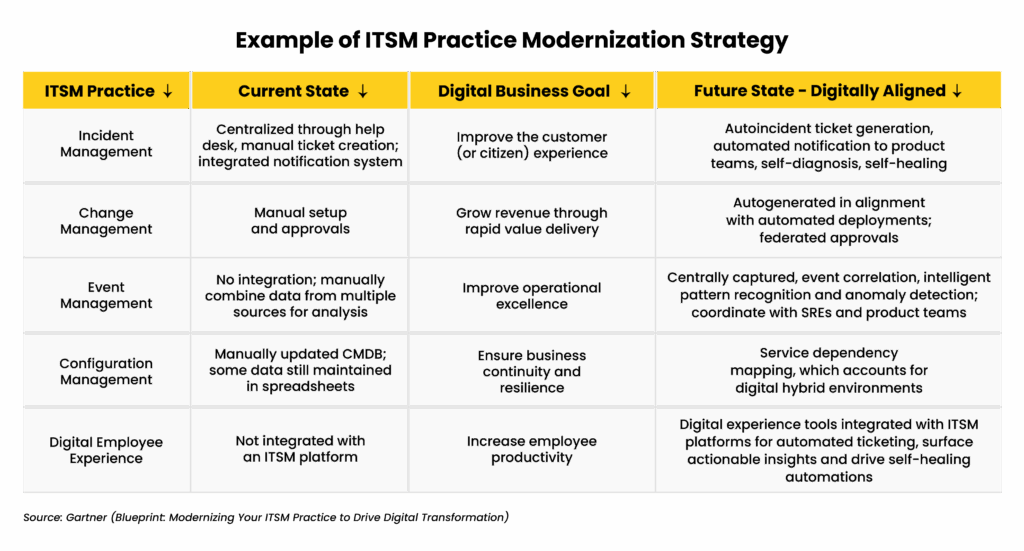In brief:
- In today’s hybrid workforce, nearly 80% of IT teams face rising service volumes at the same time labor shortages stretch IT departments thin.
- The benefits of ITSM are clear: providing the tools, automation, and structure to standardize services, boost efficiency, and align IT with business needs.
- With two-thirds of IT organizations missing revenue targets due to skills shortages, outsourcing ITSM provides instant access to the people, processes, and technology that lead to sustainable success.
IT is no longer just a back-office support function – it’s a strategic driver of growth, efficiency, and smarter business decisions. Yet many teams remain stuck in reactive, break-fix models, leading to missed opportunities, poor service, and rising end-user frustration.
The challenge is growing. Remote and hybrid work models are fueling higher help desk ticket volumes, while labor shortages and tighter budgets stretch IT teams thin. Nearly one in four IT professionals (23%) say a colleague has already quit from burnout (Ivanti 2024 Everywhere Work Report).
Adopting IT service management (ITSM) best practices is key to solving these challenges – while transitioning IT from functional experts into the strategic partner the business truly needs. Structured ITSM practices give IT teams the tools and processes to standardize services, boost efficiency, and align IT with business needs.
Let’s examine how ITSM benefits translate into tangible business value.
What is IT service management?
ITSM establishes processes and procedures that optimize the use of technology and the services built around it. It covers everything that falls under the IT umbrella, from incident management and service request resolution to the implementation of IT operations and asset management.
The benefits of IT service management stem from its core objective: aligning IT services with an organization’s strategic goals. ITSM focuses IT on delivering value to internal customers, with key targets that include:
- A proactive, process-oriented approach to service management
- Better alignment with business needs
- Increasing efficiency and effectiveness to lower IT costs and increase ROI
- Greater transparency and accountability
- Continuous addition of new functions that drive user satisfaction
- Driving digital transformation through ITSM tools that enable next-generation technologies like automation
ITSM typically goes hand-in-hand with an IT Infrastructure Library (ITIL) framework, and it’s a common misconception that they’re interchangeable. Think of it this way: ITSM is the practice of planning and delivering IT services; ITIL is one of the most widely adopted service management frameworks that generally guides how ITSM is implemented.
The importance of IT service management for your business
ITSM isn’t just about improving IT operations – it delivers measurable business value that strengthens performance across the entire organization and aligns IT initiatives with overall business strategy. Here are 5 important IT service management benefits for your organization:
1. ITSM delivers IT as a service
ITSM is based on the idea that IT exists to deliver a service to the business. Its policies and procedures are carefully structured so IT professionals can work smarter, faster, and truly benefit the organization as a whole.
Instead of working in silos and reacting to incidents in an ad hoc manner that often feels frustratingly slow to end users, IT service management structures IT service delivery like a business. That includes repeatable and scalable best practice processes, clearly defined roles and responsibilities for IT staff, an easy-to-understand catalog of services tailored to organizational needs, a reliable service desk, and a method for measuring and improving operational performance- from incident handling to service request management.
As a result, the business perceives IT as a strategic partner for continual service improvement, enhancing organizational efficiency, delivering actionable insights, and proactively solving problems. The importance of IT service management also lies in its ability to give IT service delivery the flexibility to adapt quickly to changing business needs, a key benefit of ITSM practices.
2. A well-run IT department improves overall performance and productivity
In today’s digital world, a well-run IT department is a necessity, not a luxury. For instance: 84% of IT leaders say managing cloud spend is their biggest challenge, exceeding budgets by an average of 17% (Flexera 2025 State of the Cloud Report).
ITSM practices help the entire business function at its best by creating a more efficient, productive IT department that delivers better-fitting services and improves oversight of IT resources through effective asset management..
For instance, ITSM processes build metrics for assessing IT performance, enabling quick adjustments that keep service levels high and maintain consistent service quality. They also utilize ITIL guidelines to establish standardized processes for problem management so concerning trends are identified and addressed at an early stage before they significantly impact business performance.
Change management is another key area ITIL covers to minimize costly business disruptions, ensuring smoother transitions and fewer interruptions to service desk operations. Managing change properly creates a nimble IT environment that can respond quickly to new requirements without impacting the availability of critical services.
ITSM also strengthens the relationship between the business and IT with structured processes for streamlining communication. Building a high-performance service desk, for example, creates a clear pathway for keeping operations running smoothly and boosting user satisfaction with an effortless technology experience.
3. IT service management tools drive automation and self-service
Businesses are accelerating spending on next-gen technologies amid growing competition, uncertain economic conditions, and rapid technological advancements. IDC projects that global investment in digital transformation will approach $4 trillion by 2028, accounting for about 70% of IT spend (2025 Digital Transformation Spending Guide).
To cope with this fast-paced change, service management processes need to become more agile and responsive. But while Gartner reports 73% of CIOs and tech executives have increased their AI funding to drive efficiency, most organizations remain in the experimental phase.
Many IT activities involve mundane, repetitive tasks – like onboarding employees – that ITSM can streamline through automation and modern service management software. Modern, AI-enabled ITSM amplifies your ability to build well-run IT departments with stronger service mindsets, sharper business insight, and faster speed to market.
Applying ITSM automation also lowers operational costs and eliminates the human error that typically plagues repetitive tasks, while freeing IT staff for higher-value work.
- 79% of IT leaders expect AI to revolutionize incident management
- 73% anticipate major gains in knowledge management
- 63% see faster service-request fulfillment
Self-service capabilities are another way ITSM tools drive efficiency. For instance, ITIL knowledge management processes create a knowledge base that users can access to fulfill common service request management tasks without involving help desk staff, reducing strain on IT teams.

4. ITSM establishes greater control and oversight for IT operations
ITSM isn’t just about improving IT operations – it delivers measurable business value that strengthens performance across the entire organization and aligns IT initiatives with overall business strategy. Here are 5 important IT service management benefits for your organization:
Under a reactive service model, any IT professional might be assigned to any incoming issue, with multiple people making changes to the same incident. This often causes confusion about priorities, roles and responsibilities, appropriate service levels, decision-making authority, and collaboration during incident resolution.
ITSM builds a structure that creates transparency and accountability. Formalizing focus for IT staff and standardizing processes for basic IT functions creates a visible line of sight between individual contributions and business results.
When IT staff have clear roles, they become accountable for the services they are responsible for delivering. Standardizing ITSM also leads to more predictable results and faster, timely service delivery. With a well-managed service model in place, organizations gain a single point of contact that ensures requests are logged, tracked, and resolved constantly.
5. Implementing IT service management transforms IT into a strategic partner for the business
The number of day-to-day operational activities IT must handle isn’t going away – in fact, it’s growing. Nearly 80% of IT teams report increased workloads due to hybrid/remote work models, juggling more service desk requests, service request backlogs, and the need to manage a growing shadow IT footprint, the Ivanti report found.
Given this, perhaps the greatest value ITSM provides is the bandwidth it delivers to focus on activities that drive innovation and growth.
By optimizing time-consuming, routine tasks with standardization, more efficient processes, and automation – and routing them appropriately to junior team members – ITSM frees senior IT staff to focus on strategic services that add commercial value, extending the value of enterprise service management beyond IT to improve operations across the business.
Why Auxis: Accelerate adoption of ITSM best practices
The importance of IT service management is clear – helping companies achieve greater efficiencies, reduce costs, and limit risks. But ongoing IT labor shortages make it difficult for companies to implement ITSM in-house.
Nearly two-thirds of IT leaders say IT skills shortages have caused them to miss revenue targets, and experience product delays, quality problems, and reduced customer satisfaction, according to IDC’s 2024 IT Skilling Strategies report. By 2026, IDC forecasts more than 90% of organizations worldwide will feel the pain of the IT skills crisis, amounting to some $5.5 trillion in losses caused by product delays, impaired competitiveness, and loss of business.
Outsourcing your ITSM practices to a reputable managed services provider like Auxis can instantly deliver the people, processes, and technology that lead to success. Exceptional outsourcers have deep experience implementing ITSM best practices, access to the latest technologies, and motivation to meet and exceed contractual service levels by driving efficient, continuous improvement in your organization.
Today, IT services are more critical to business success than ever before. Outsourcing service management solutions to an exceptional managed service provider allows you to benefit from cost-effective, efficient, and scalable IT solutions and stay ahead in a competitive market.
Want to learn more about ITSM best practices and how to implement them? Schedule a consultation with our IT service leaders today! Or visit our resource center to learn more IT trends, strategies, and success stories.
Frequently Asked Questions
1. What are the benefits of IT service management for a business?
2. Will IT service management save money for my organization?
3. Does ITSM improve customer and employee experiences?
4. What is the importance of IT service management for supporting business growth?
5. How can businesses get started with ITSM best practices?




